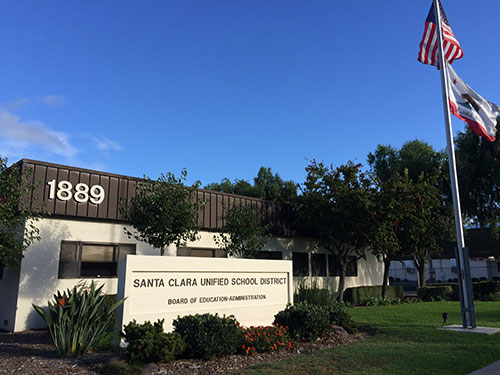
Retta Conley Robertson entered the AP class for parenting when her dyslexic daughter lost her Individualized Education Program (IEP), a benefit for special needs students, at the end of her kindergarten year. Observing her daughter’s struggles in subsequent years, Robertson transferred her to Belmont’s Charles Armstrong School, a private school for dyslexic children. At the new school, Robertson’s daughter thrived.
“Once we left Charles Armstrong, we ended up at Discovery Charter School… then my daughter decided she wanted to go to a bigger school for high school and get on a performance team,” Robertson says. “The Discovery Charter School District determined she was eligible for an IEP. IEPs are transferrable and by law, it had to be transferred to Santa Clara Unified, which earlier said she didn’t have a learning disability. She entered Wilcox and did pretty well in terms of her transitioning. She tried out for cheer and got on the team.”
Jennifer Dericco, SCUSD’s public information officer, elaborates on what an IEP is and how the program is evaluated.
“The Individualized Education Program (IEP) is a written document developed by a team for a student who is eligible for special education services,” Dericco writes in an email. “A student’s team consists of general education staff, special education staff, administrators, parents/guardians, the student, and any service providers (speech and language therapists, occupational therapists, physical therapists, etc.). Together, the team determines the accommodations, goals, and objectives the student will need in order to succeed…There are accountability checks in place at the federal, state, and district levels.”
Dericco encourages parents of special needs children to participate in their child’s IEP team, attend parenting workshops, and become involved in the district’s Community Advisory Committee (CAC) that serves parents with special needs children.
Robertson currently volunteers as vice chair of the district’s CAC and is looking for CAC representatives at each school to help with putting up flyers. She also hosts a monthly coffee meet up for parents with special needs children. In addition, she is advocating for an inclusion and social skills program called Circle of Friends. Dericco says that funding would be one of the district’s challenges for starting up Circle of Friends, as it will cost approximately $12,000 each year for three years of participation in the program.
“My relationship with the district has gotten better and now I’m trying to be a support to other parents so they know what their rights are,” Robertson says. “At Wilcox, I find the teachers are willing to help. There are many teachers who really go out of their way to help their students. We now have a new case manager and she works so well with my daughter. My daughter is currently in an AP class and she has had honors classes in the past. For someone with dyslexia to be able to do that, it is with the help of the case manager and the teachers. So my story does have a happy ending.”
Visit http://selpa7cac.webs.com/parent-events to view dates and topics of future CAC meetings. For more information about parental involvement in the district’s special needs community, email rconleyrobertson@gmail.com.





